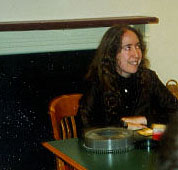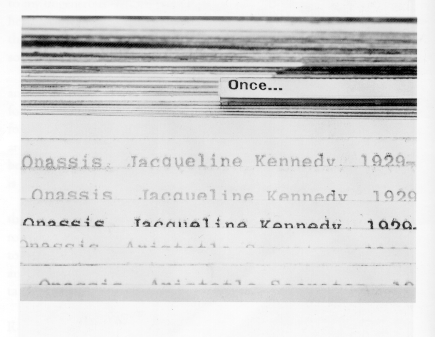

Erica Baum's photographic art captures only alphabetically related terms and puts them into new context. Her photographs are archaic storage systems of knowledge yielding randomly found commentaries, creating landscapes of words, as "subject headings" appear over the vistas of information sheets formed by unexposed cards in card catalogue drawers. How much a particular set of words is revealed, by the angle of the shot, is the essence of Baum's humor. "The self-consciousness" entailed in the act of cataloguing the catalogue, wrote Christopher Chamgers in NY Arts (9/13/97), "intimates the transcience and fragility of human accomplishments. It is our learning that makes the endless concatenation of teaching ironic."
Baum's shows have been hosted by D'Amelio Terras, Clementine Gallery, and elsewhere.
 |
| Erica Baum, 1997-98; courtesy of D'Amelio Terras Gallery (click on the image) |
In Baum's art, "the act of information retrieval is turned into a journey," writes Josefine Raab, "--of seemingly unknown destination." Baum will produce a picture of related terms (words and phrases) in alphabetical order, so that for instance the term "Subversive Activities" will appear next to "Suburban Homes" (from Untitled (Suburban), 1997, gelatin silver print, 20x24 inches, shown at Clementine Gallery, New York). The result is what Alice Thorson sees as "a form of found minimalist poetry." Words photographed from an index are lineated like poetry, for example:
Baum's photographs of such index fragments appear to have been taken from grainy and enlarged photocopies, a setp that engages them in a dialogue with abstract painting while also invoking the pervasiveness of technology.rain cause of, 59-63 what to do when lost in, 185-186
In the February 1998 issue of Art in America, Grady Turner reviewed Baum's exhibit at the Clementine:
As libraries make the transition to computerized catalogues, many still rely on drawers of index cards. In most respects card catalogues are no match for computer databases, but the quaintly fastidious cards, smudged by the fingers of past researchers, remain far more likely to yield serendipitous discoveries and seem to have far more appeal as raw material for art works.... Erica Baum approaches [card catalogues] with a linguist'sAn example is Baum's photo of an open drawer with tab dividers placing "fasts and feasts" so close to "fat," with "fate and fatalism" looming just out of focus in the background. Another photo of such a drawer discloses "Jersey City--Jesus" and "Sex Differences--Shirts."eye for found poetry, discovering unintended relationships in random names and phrases filed in alphabetical order. While Baum is obviously well-versed in language theory, her black-and-white photographs of outmoded catalogues have a dry wit typically lacking in post-structuralist discourse about archives.
Turner contentds that Baum "exposes a Dadaist absurdity perhaps closer to Fluxus puns than to Duchampian metaphysics." "Textual without becoming didactic, Baum's linguistic play is informed by our era."
"Fragments of an index," Baum writes (in a statement dated April 2000), "reveal the unexpected fictions, rhythms and poetry hidden with a book's internal system of reference... A tension is created between what is absent, the book, and what is present, the concatenation of sounds and meanings wrenched from their source.... When the index selections are xeroxed and enlarged other bits of visual information turn up haphazardly. The woven texture of a clothbound book and its pages, dots on the flatbed, and other pictorial noise are reworked into the final image which is then scanned in a computer and processed to create these digitally exposed white and dark dark blue C prints."
See a a list of Erica Baum's exhibits.

Erica Baum at the Writers House, November 17,
2000..